Business Analytics Report: Sustainability and Digital Analytics
VerifiedAdded on 2020/02/19
|6
|1605
|495
Report
AI Summary
This report provides a comprehensive overview of business analytics, exploring its core concepts and applications. It begins with an introduction to business analytics, emphasizing its role in data-driven decision-making and its past, present, and future dimensions. The report then delves into the concept of competitive advantage, illustrating how business analytics supports price leadership, sustainability, operational efficiency, and innovation. It further examines how business analytics aids in decision-making by increasing customer profitability, reducing risk, and optimizing merchandise. The report also highlights the role of business analytics in achieving sustainability by efficiently allocating resources. Finally, it defines digital analytics and its importance in understanding user behavior. The report concludes by emphasizing the crucial role of business analytics in driving change and fostering competitive advantages within organizations.
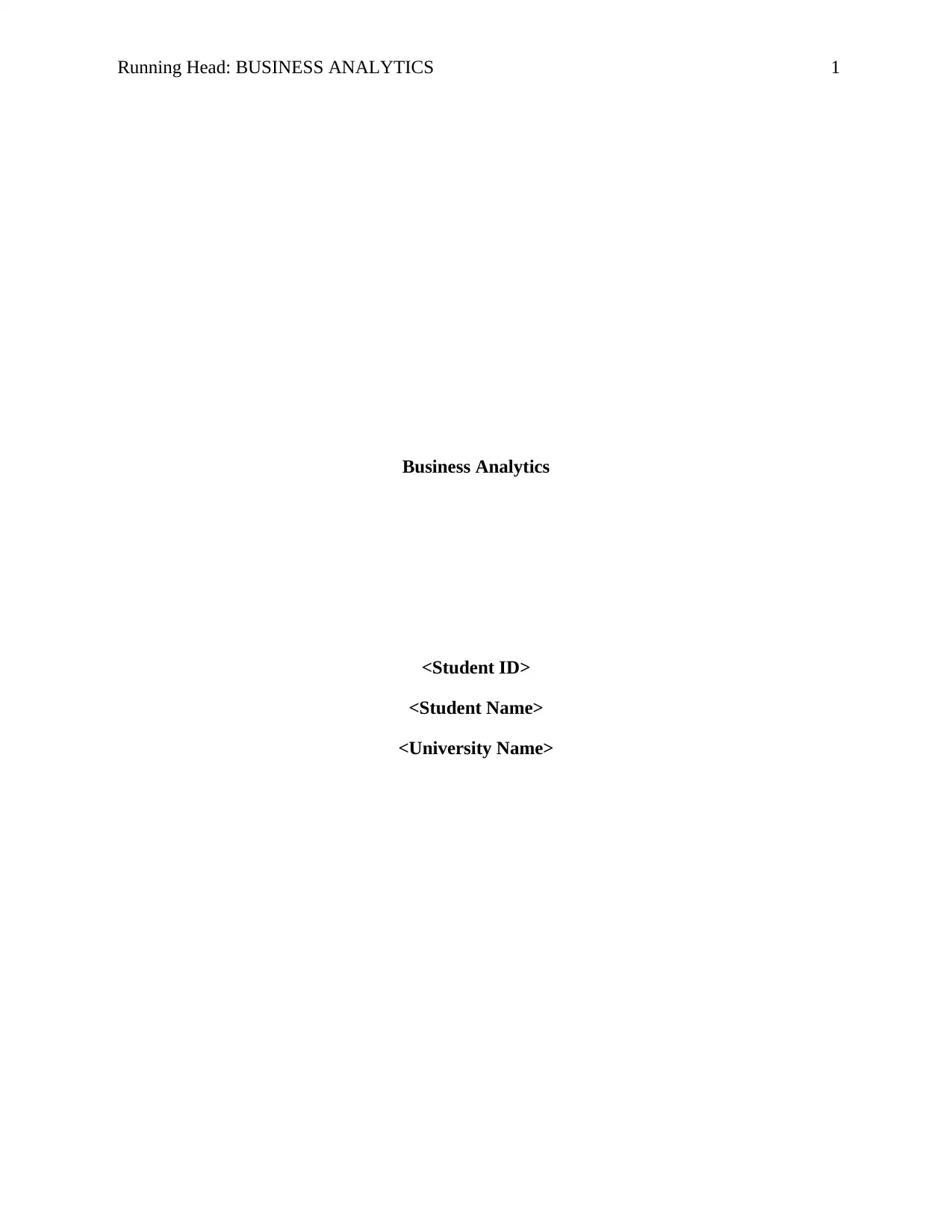
Running Head: BUSINESS ANALYTICS 1
Business Analytics
<Student ID>
<Student Name>
<University Name>
Business Analytics
<Student ID>
<Student Name>
<University Name>
Paraphrase This Document
Need a fresh take? Get an instant paraphrase of this document with our AI Paraphraser
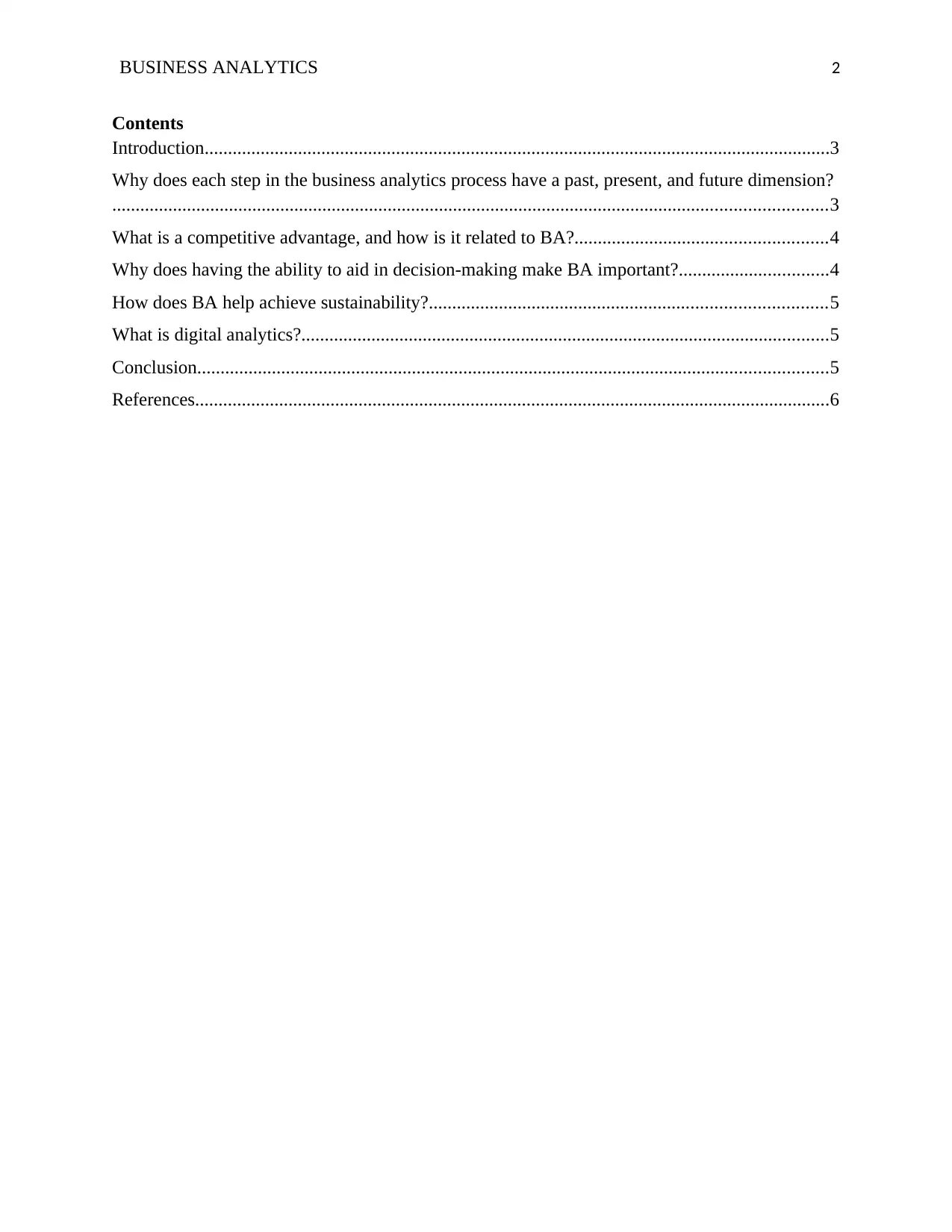
BUSINESS ANALYTICS 2
Contents
Introduction......................................................................................................................................3
Why does each step in the business analytics process have a past, present, and future dimension?
.........................................................................................................................................................3
What is a competitive advantage, and how is it related to BA?......................................................4
Why does having the ability to aid in decision-making make BA important?................................4
How does BA help achieve sustainability?.....................................................................................5
What is digital analytics?.................................................................................................................5
Conclusion.......................................................................................................................................5
References........................................................................................................................................6
Contents
Introduction......................................................................................................................................3
Why does each step in the business analytics process have a past, present, and future dimension?
.........................................................................................................................................................3
What is a competitive advantage, and how is it related to BA?......................................................4
Why does having the ability to aid in decision-making make BA important?................................4
How does BA help achieve sustainability?.....................................................................................5
What is digital analytics?.................................................................................................................5
Conclusion.......................................................................................................................................5
References........................................................................................................................................6
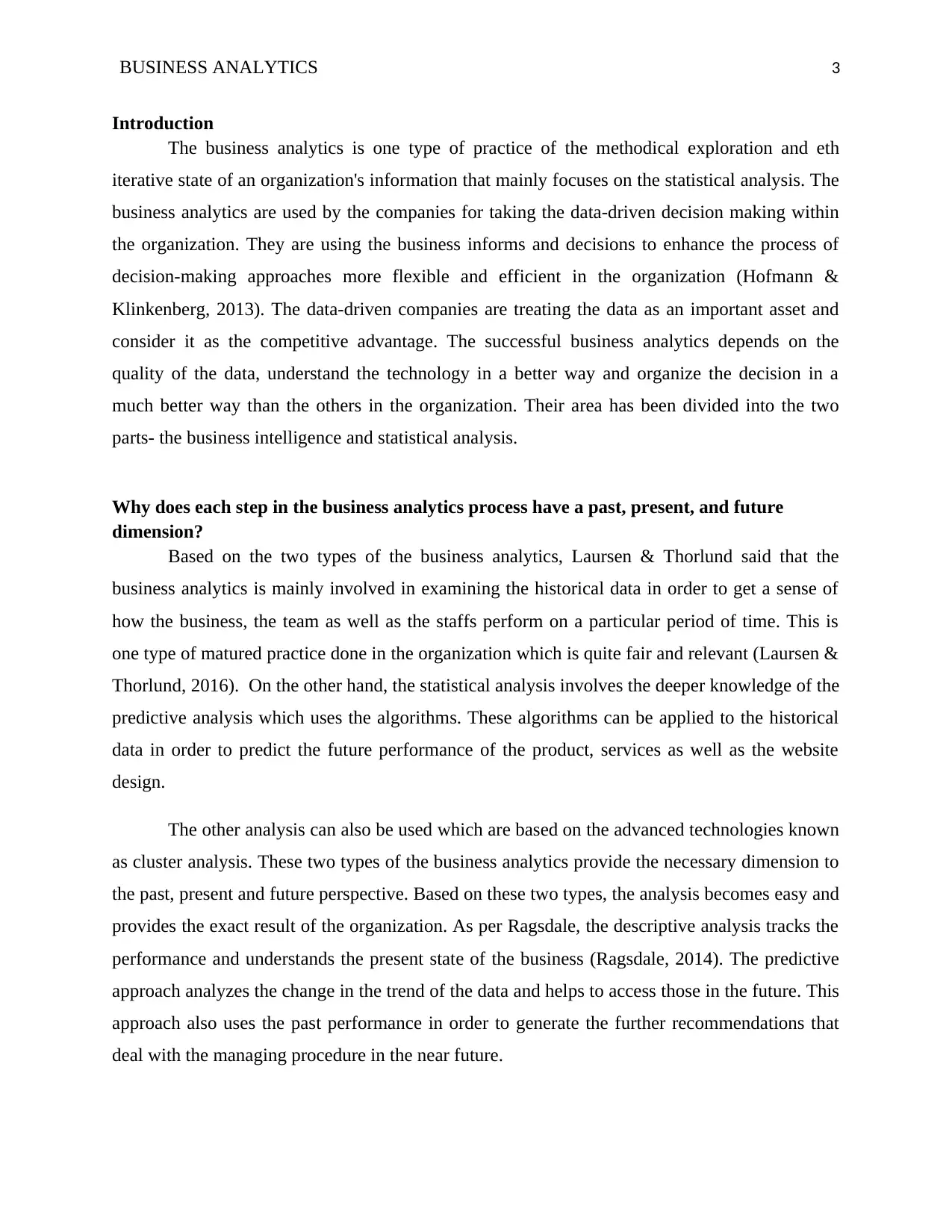
BUSINESS ANALYTICS 3
Introduction
The business analytics is one type of practice of the methodical exploration and eth
iterative state of an organization's information that mainly focuses on the statistical analysis. The
business analytics are used by the companies for taking the data-driven decision making within
the organization. They are using the business informs and decisions to enhance the process of
decision-making approaches more flexible and efficient in the organization (Hofmann &
Klinkenberg, 2013). The data-driven companies are treating the data as an important asset and
consider it as the competitive advantage. The successful business analytics depends on the
quality of the data, understand the technology in a better way and organize the decision in a
much better way than the others in the organization. Their area has been divided into the two
parts- the business intelligence and statistical analysis.
Why does each step in the business analytics process have a past, present, and future
dimension?
Based on the two types of the business analytics, Laursen & Thorlund said that the
business analytics is mainly involved in examining the historical data in order to get a sense of
how the business, the team as well as the staffs perform on a particular period of time. This is
one type of matured practice done in the organization which is quite fair and relevant (Laursen &
Thorlund, 2016). On the other hand, the statistical analysis involves the deeper knowledge of the
predictive analysis which uses the algorithms. These algorithms can be applied to the historical
data in order to predict the future performance of the product, services as well as the website
design.
The other analysis can also be used which are based on the advanced technologies known
as cluster analysis. These two types of the business analytics provide the necessary dimension to
the past, present and future perspective. Based on these two types, the analysis becomes easy and
provides the exact result of the organization. As per Ragsdale, the descriptive analysis tracks the
performance and understands the present state of the business (Ragsdale, 2014). The predictive
approach analyzes the change in the trend of the data and helps to access those in the future. This
approach also uses the past performance in order to generate the further recommendations that
deal with the managing procedure in the near future.
Introduction
The business analytics is one type of practice of the methodical exploration and eth
iterative state of an organization's information that mainly focuses on the statistical analysis. The
business analytics are used by the companies for taking the data-driven decision making within
the organization. They are using the business informs and decisions to enhance the process of
decision-making approaches more flexible and efficient in the organization (Hofmann &
Klinkenberg, 2013). The data-driven companies are treating the data as an important asset and
consider it as the competitive advantage. The successful business analytics depends on the
quality of the data, understand the technology in a better way and organize the decision in a
much better way than the others in the organization. Their area has been divided into the two
parts- the business intelligence and statistical analysis.
Why does each step in the business analytics process have a past, present, and future
dimension?
Based on the two types of the business analytics, Laursen & Thorlund said that the
business analytics is mainly involved in examining the historical data in order to get a sense of
how the business, the team as well as the staffs perform on a particular period of time. This is
one type of matured practice done in the organization which is quite fair and relevant (Laursen &
Thorlund, 2016). On the other hand, the statistical analysis involves the deeper knowledge of the
predictive analysis which uses the algorithms. These algorithms can be applied to the historical
data in order to predict the future performance of the product, services as well as the website
design.
The other analysis can also be used which are based on the advanced technologies known
as cluster analysis. These two types of the business analytics provide the necessary dimension to
the past, present and future perspective. Based on these two types, the analysis becomes easy and
provides the exact result of the organization. As per Ragsdale, the descriptive analysis tracks the
performance and understands the present state of the business (Ragsdale, 2014). The predictive
approach analyzes the change in the trend of the data and helps to access those in the future. This
approach also uses the past performance in order to generate the further recommendations that
deal with the managing procedure in the near future.
⊘ This is a preview!⊘
Do you want full access?
Subscribe today to unlock all pages.

Trusted by 1+ million students worldwide
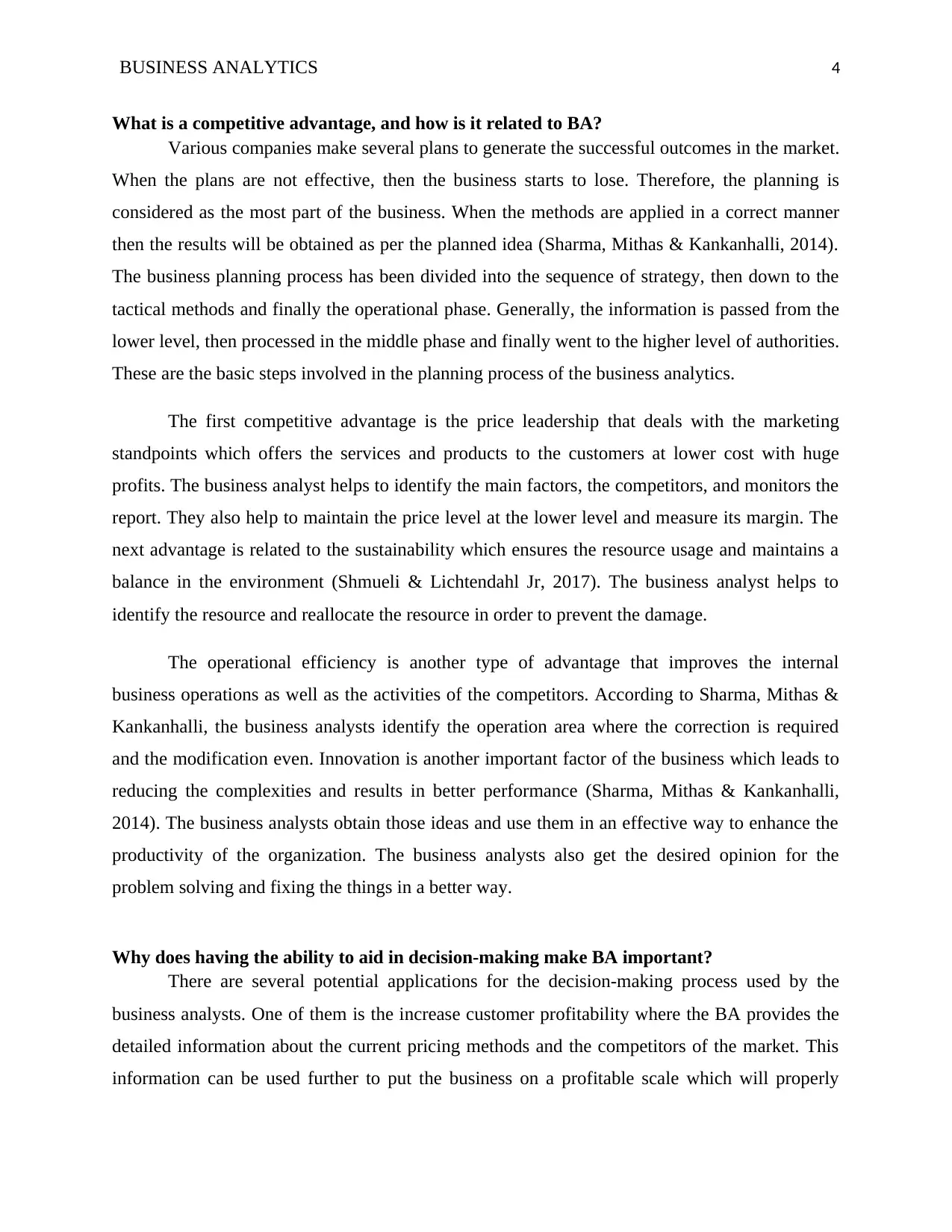
BUSINESS ANALYTICS 4
What is a competitive advantage, and how is it related to BA?
Various companies make several plans to generate the successful outcomes in the market.
When the plans are not effective, then the business starts to lose. Therefore, the planning is
considered as the most part of the business. When the methods are applied in a correct manner
then the results will be obtained as per the planned idea (Sharma, Mithas & Kankanhalli, 2014).
The business planning process has been divided into the sequence of strategy, then down to the
tactical methods and finally the operational phase. Generally, the information is passed from the
lower level, then processed in the middle phase and finally went to the higher level of authorities.
These are the basic steps involved in the planning process of the business analytics.
The first competitive advantage is the price leadership that deals with the marketing
standpoints which offers the services and products to the customers at lower cost with huge
profits. The business analyst helps to identify the main factors, the competitors, and monitors the
report. They also help to maintain the price level at the lower level and measure its margin. The
next advantage is related to the sustainability which ensures the resource usage and maintains a
balance in the environment (Shmueli & Lichtendahl Jr, 2017). The business analyst helps to
identify the resource and reallocate the resource in order to prevent the damage.
The operational efficiency is another type of advantage that improves the internal
business operations as well as the activities of the competitors. According to Sharma, Mithas &
Kankanhalli, the business analysts identify the operation area where the correction is required
and the modification even. Innovation is another important factor of the business which leads to
reducing the complexities and results in better performance (Sharma, Mithas & Kankanhalli,
2014). The business analysts obtain those ideas and use them in an effective way to enhance the
productivity of the organization. The business analysts also get the desired opinion for the
problem solving and fixing the things in a better way.
Why does having the ability to aid in decision-making make BA important?
There are several potential applications for the decision-making process used by the
business analysts. One of them is the increase customer profitability where the BA provides the
detailed information about the current pricing methods and the competitors of the market. This
information can be used further to put the business on a profitable scale which will properly
What is a competitive advantage, and how is it related to BA?
Various companies make several plans to generate the successful outcomes in the market.
When the plans are not effective, then the business starts to lose. Therefore, the planning is
considered as the most part of the business. When the methods are applied in a correct manner
then the results will be obtained as per the planned idea (Sharma, Mithas & Kankanhalli, 2014).
The business planning process has been divided into the sequence of strategy, then down to the
tactical methods and finally the operational phase. Generally, the information is passed from the
lower level, then processed in the middle phase and finally went to the higher level of authorities.
These are the basic steps involved in the planning process of the business analytics.
The first competitive advantage is the price leadership that deals with the marketing
standpoints which offers the services and products to the customers at lower cost with huge
profits. The business analyst helps to identify the main factors, the competitors, and monitors the
report. They also help to maintain the price level at the lower level and measure its margin. The
next advantage is related to the sustainability which ensures the resource usage and maintains a
balance in the environment (Shmueli & Lichtendahl Jr, 2017). The business analyst helps to
identify the resource and reallocate the resource in order to prevent the damage.
The operational efficiency is another type of advantage that improves the internal
business operations as well as the activities of the competitors. According to Sharma, Mithas &
Kankanhalli, the business analysts identify the operation area where the correction is required
and the modification even. Innovation is another important factor of the business which leads to
reducing the complexities and results in better performance (Sharma, Mithas & Kankanhalli,
2014). The business analysts obtain those ideas and use them in an effective way to enhance the
productivity of the organization. The business analysts also get the desired opinion for the
problem solving and fixing the things in a better way.
Why does having the ability to aid in decision-making make BA important?
There are several potential applications for the decision-making process used by the
business analysts. One of them is the increase customer profitability where the BA provides the
detailed information about the current pricing methods and the competitors of the market. This
information can be used further to put the business on a profitable scale which will properly
Paraphrase This Document
Need a fresh take? Get an instant paraphrase of this document with our AI Paraphraser
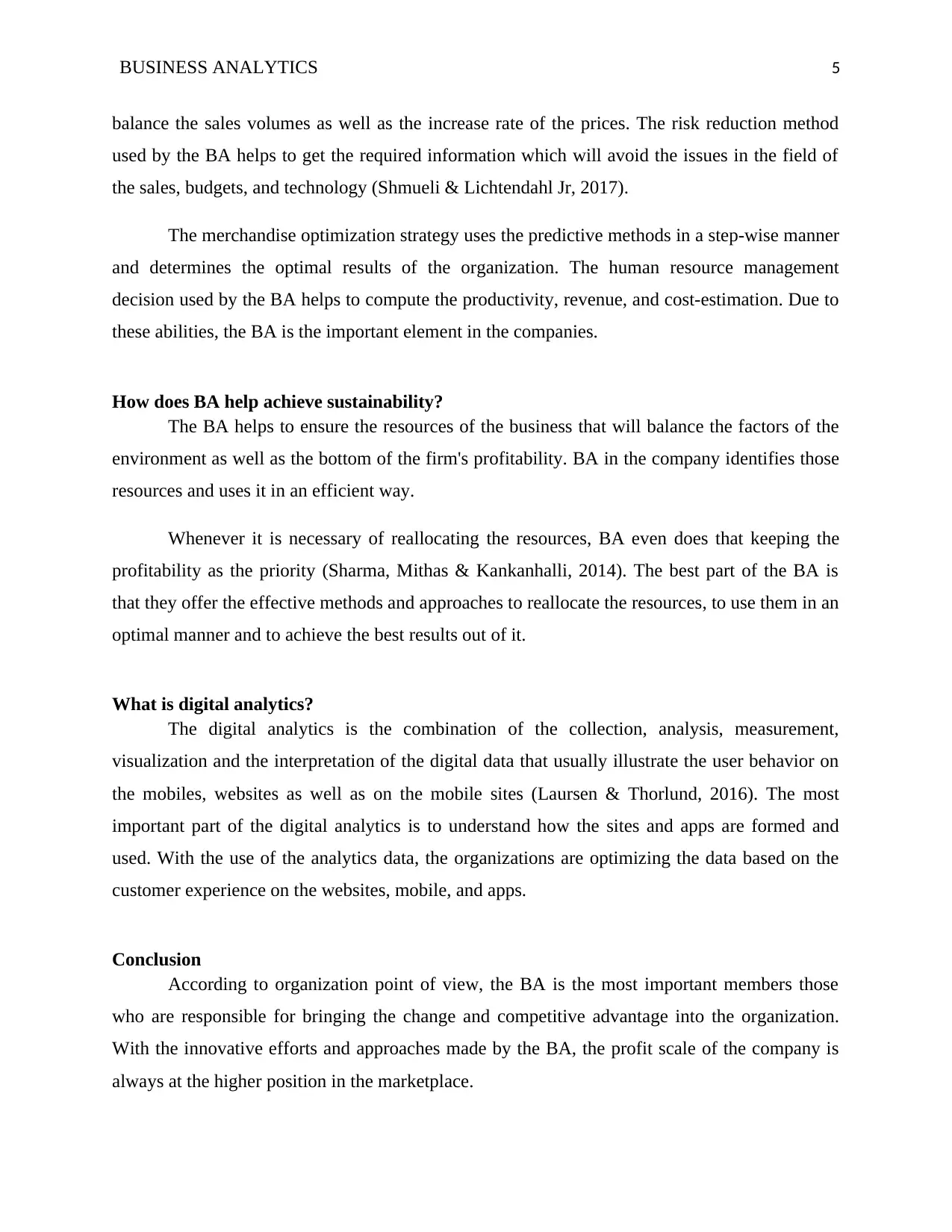
BUSINESS ANALYTICS 5
balance the sales volumes as well as the increase rate of the prices. The risk reduction method
used by the BA helps to get the required information which will avoid the issues in the field of
the sales, budgets, and technology (Shmueli & Lichtendahl Jr, 2017).
The merchandise optimization strategy uses the predictive methods in a step-wise manner
and determines the optimal results of the organization. The human resource management
decision used by the BA helps to compute the productivity, revenue, and cost-estimation. Due to
these abilities, the BA is the important element in the companies.
How does BA help achieve sustainability?
The BA helps to ensure the resources of the business that will balance the factors of the
environment as well as the bottom of the firm's profitability. BA in the company identifies those
resources and uses it in an efficient way.
Whenever it is necessary of reallocating the resources, BA even does that keeping the
profitability as the priority (Sharma, Mithas & Kankanhalli, 2014). The best part of the BA is
that they offer the effective methods and approaches to reallocate the resources, to use them in an
optimal manner and to achieve the best results out of it.
What is digital analytics?
The digital analytics is the combination of the collection, analysis, measurement,
visualization and the interpretation of the digital data that usually illustrate the user behavior on
the mobiles, websites as well as on the mobile sites (Laursen & Thorlund, 2016). The most
important part of the digital analytics is to understand how the sites and apps are formed and
used. With the use of the analytics data, the organizations are optimizing the data based on the
customer experience on the websites, mobile, and apps.
Conclusion
According to organization point of view, the BA is the most important members those
who are responsible for bringing the change and competitive advantage into the organization.
With the innovative efforts and approaches made by the BA, the profit scale of the company is
always at the higher position in the marketplace.
balance the sales volumes as well as the increase rate of the prices. The risk reduction method
used by the BA helps to get the required information which will avoid the issues in the field of
the sales, budgets, and technology (Shmueli & Lichtendahl Jr, 2017).
The merchandise optimization strategy uses the predictive methods in a step-wise manner
and determines the optimal results of the organization. The human resource management
decision used by the BA helps to compute the productivity, revenue, and cost-estimation. Due to
these abilities, the BA is the important element in the companies.
How does BA help achieve sustainability?
The BA helps to ensure the resources of the business that will balance the factors of the
environment as well as the bottom of the firm's profitability. BA in the company identifies those
resources and uses it in an efficient way.
Whenever it is necessary of reallocating the resources, BA even does that keeping the
profitability as the priority (Sharma, Mithas & Kankanhalli, 2014). The best part of the BA is
that they offer the effective methods and approaches to reallocate the resources, to use them in an
optimal manner and to achieve the best results out of it.
What is digital analytics?
The digital analytics is the combination of the collection, analysis, measurement,
visualization and the interpretation of the digital data that usually illustrate the user behavior on
the mobiles, websites as well as on the mobile sites (Laursen & Thorlund, 2016). The most
important part of the digital analytics is to understand how the sites and apps are formed and
used. With the use of the analytics data, the organizations are optimizing the data based on the
customer experience on the websites, mobile, and apps.
Conclusion
According to organization point of view, the BA is the most important members those
who are responsible for bringing the change and competitive advantage into the organization.
With the innovative efforts and approaches made by the BA, the profit scale of the company is
always at the higher position in the marketplace.
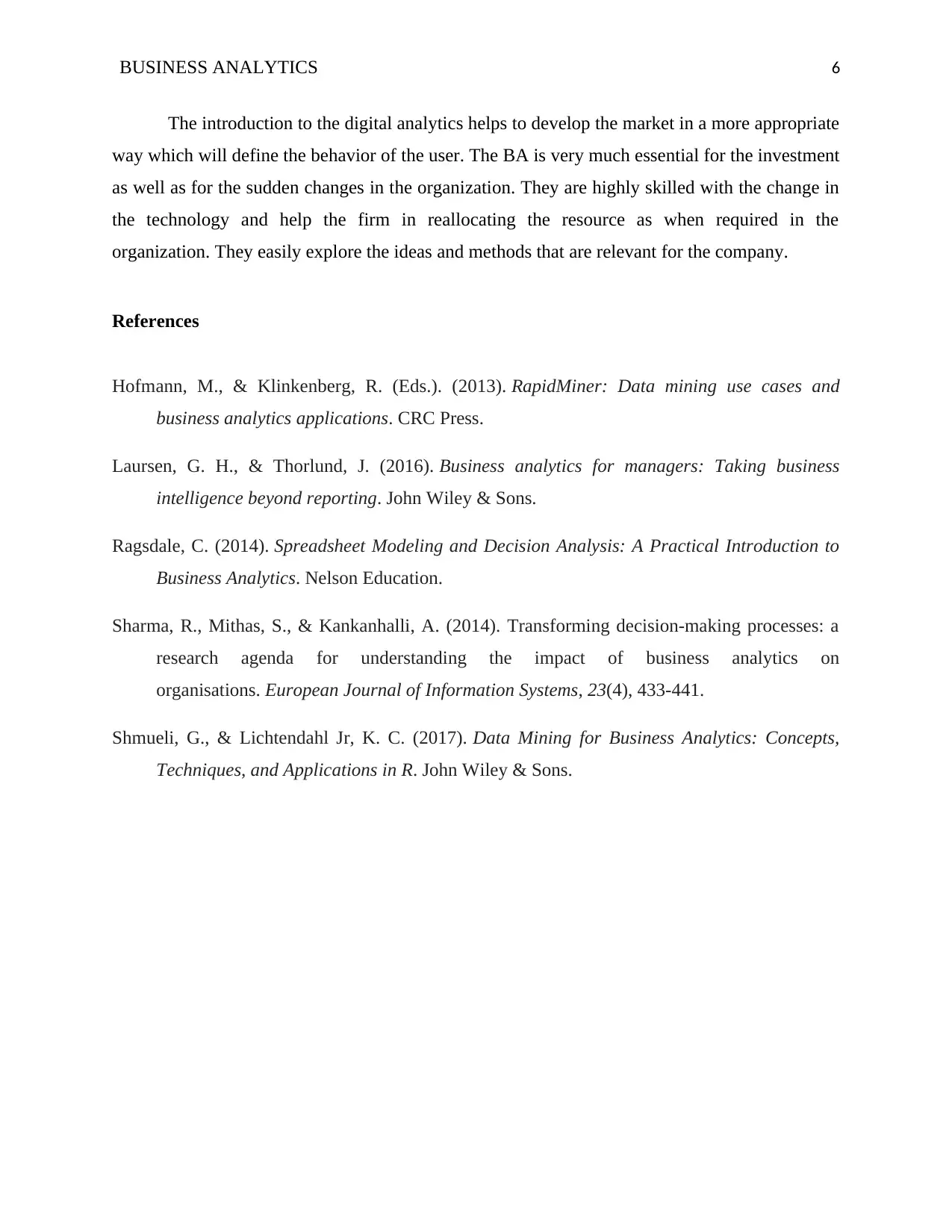
BUSINESS ANALYTICS 6
The introduction to the digital analytics helps to develop the market in a more appropriate
way which will define the behavior of the user. The BA is very much essential for the investment
as well as for the sudden changes in the organization. They are highly skilled with the change in
the technology and help the firm in reallocating the resource as when required in the
organization. They easily explore the ideas and methods that are relevant for the company.
References
Hofmann, M., & Klinkenberg, R. (Eds.). (2013). RapidMiner: Data mining use cases and
business analytics applications. CRC Press.
Laursen, G. H., & Thorlund, J. (2016). Business analytics for managers: Taking business
intelligence beyond reporting. John Wiley & Sons.
Ragsdale, C. (2014). Spreadsheet Modeling and Decision Analysis: A Practical Introduction to
Business Analytics. Nelson Education.
Sharma, R., Mithas, S., & Kankanhalli, A. (2014). Transforming decision-making processes: a
research agenda for understanding the impact of business analytics on
organisations. European Journal of Information Systems, 23(4), 433-441.
Shmueli, G., & Lichtendahl Jr, K. C. (2017). Data Mining for Business Analytics: Concepts,
Techniques, and Applications in R. John Wiley & Sons.
The introduction to the digital analytics helps to develop the market in a more appropriate
way which will define the behavior of the user. The BA is very much essential for the investment
as well as for the sudden changes in the organization. They are highly skilled with the change in
the technology and help the firm in reallocating the resource as when required in the
organization. They easily explore the ideas and methods that are relevant for the company.
References
Hofmann, M., & Klinkenberg, R. (Eds.). (2013). RapidMiner: Data mining use cases and
business analytics applications. CRC Press.
Laursen, G. H., & Thorlund, J. (2016). Business analytics for managers: Taking business
intelligence beyond reporting. John Wiley & Sons.
Ragsdale, C. (2014). Spreadsheet Modeling and Decision Analysis: A Practical Introduction to
Business Analytics. Nelson Education.
Sharma, R., Mithas, S., & Kankanhalli, A. (2014). Transforming decision-making processes: a
research agenda for understanding the impact of business analytics on
organisations. European Journal of Information Systems, 23(4), 433-441.
Shmueli, G., & Lichtendahl Jr, K. C. (2017). Data Mining for Business Analytics: Concepts,
Techniques, and Applications in R. John Wiley & Sons.
⊘ This is a preview!⊘
Do you want full access?
Subscribe today to unlock all pages.

Trusted by 1+ million students worldwide
1 out of 6
Related Documents
Your All-in-One AI-Powered Toolkit for Academic Success.
+13062052269
info@desklib.com
Available 24*7 on WhatsApp / Email
![[object Object]](/_next/static/media/star-bottom.7253800d.svg)
Unlock your academic potential
Copyright © 2020–2025 A2Z Services. All Rights Reserved. Developed and managed by ZUCOL.





